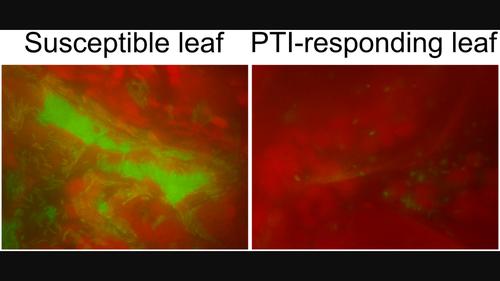当前位置:
X-MOL 学术
›
Mol. Plant Pathol.
›
论文详情
Our official English website, www.x-mol.net, welcomes your feedback! (Note: you will need to create a separate account there.)
Exploring Pseudomonas syringae pv. tomato biofilm-like aggregate formation in susceptible and PTI-responding Arabidopsis thaliana
Molecular Plant Pathology ( IF 4.9 ) Pub Date : 2023-11-21 , DOI: 10.1111/mpp.13403 Wantao N Xiao 1 , Garrett M Nunn 1 , Angela B Fufeng 1 , Natalie Belu 1 , Rowan K Brookman 1 , Abdul Halim 1 , Evan C Krysmanski 1 , Robin K Cameron 1
Molecular Plant Pathology ( IF 4.9 ) Pub Date : 2023-11-21 , DOI: 10.1111/mpp.13403 Wantao N Xiao 1 , Garrett M Nunn 1 , Angela B Fufeng 1 , Natalie Belu 1 , Rowan K Brookman 1 , Abdul Halim 1 , Evan C Krysmanski 1 , Robin K Cameron 1
Affiliation

|
Bacterial biofilm-like aggregates have been observed in plants, but their role in pathogenicity is underinvestigated. In the present study, we observed that extracellular DNA and polysaccharides colocalized with green fluorescent protein (GFP)-expressing Pseudomonas syringae pv. tomato (Pst) aggregates in Arabidopsis leaves, suggesting that Pst aggregates are biofilms. GFP-expressing Pst, Pst ΔalgU ΔmucAB (Pst algU mutant), and Pst ΔalgD ΔalgU ΔmucAB (Pst algU algD mutant) were examined to explore the roles of (1) alginate, a potential biofilm component; (2) Pst AlgU, thought to regulate alginate biosynthesis and some type III secretion system effector genes; and (3) intercellular salicylic acid (SA) accumulation during pathogen-associated molecular pattern-triggered immunity (PTI). Pst formed extensive aggregates in susceptible plants, whereas aggregate numbers and size were reduced in Pst algU and Pst algD algU mutants, and both multiplied poorly in planta, suggesting that aggregate formation contributes to Pst success in planta. However, in SA-deficient sid2-2 plants, Pst algD algU mutant multiplication and aggregate formation were partially restored, suggesting plant-produced SA contributes to suppression of Pst aggregate formation. Pst algD algU mutants formed fewer and smaller aggregates than Pst algU mutants, suggesting both AlgU and AlgD contribute to Pst aggregate formation. Col-0 plants accumulated low levels of SA in response to Pst and both mutants (Pst algU and Pst algD algU), suggesting the regulatory functions of AlgU are not involved in suppressing SA-mediated plant defence. Plant PTI was associated with highly reduced Pst aggregate formation and accumulation of intercellular SA in flg22-induced PTI-responding wild-type Col-0, but not in PTI-incompetent fls2, suggesting intercellular SA accumulation by Arabidopsis contributes to suppression of Pst biofilm-like aggregate formation during PTI.
中文翻译:

探索丁香假单胞菌 pv。易感拟南芥和 PTI 反应拟南芥中番茄生物膜样聚集体的形成
已在植物中观察到细菌生物膜样聚集体,但它们在致病性中的作用尚未得到充分研究。在本研究中,我们观察到细胞外 DNA 和多糖与表达绿色荧光蛋白 (GFP) 的丁香假单胞菌共定位。番茄(Pst) 在拟南芥叶子中聚集,表明 Pst 聚集体是生物膜。对表达 GFP 的 Pst、Pst Δ algU Δ mucAB(Pst algU突变体)和 Pst Δ algD Δ algU Δ mucAB(Pst algU algD突变体)进行了检查,以探索 (1) 海藻酸盐的作用,这是一种潜在的生物膜成分;(2) Pst AlgU,被认为调节藻酸盐生物合成和一些III型分泌系统效应基因;(3)病原体相关分子模式触发免疫(PTI)过程中细胞间水杨酸(SA)的积累。Pst 在易感植物中形成广泛的聚集体,而 Pst algU和 Pst algD algU突变体中聚集体的数量和大小均减少,并且两者在植物中繁殖不佳,表明聚集体形成有助于 Pst 在植物中的成功。然而,在SA缺陷的sid2-2植物中,Pst algD algU突变体增殖和聚集体形成部分恢复,表明植物产生的SA有助于抑制Pst聚集体形成。Pst algD algU突变体比 Pst algU突变体形成更少且更小的聚集体,表明 AlgU 和 AlgD 都有助于 Pst 聚集体的形成。Col-0 植物响应 Pst 和两种突变体(Pst algU和 Pst algD algU)积累了低水平的 SA,表明 AlgU 的调节功能不参与抑制 SA 介导的植物防御。在 flg22 诱导的 PTI 响应野生型 Col-0 中,植物 PTI 与 Pst 聚集体形成和细胞间 SA 的高度减少相关,但在 PTI 无能力的fls2中则不然,表明拟南芥细胞间 SA 的积累有助于抑制 Pst 生物膜。就像 PTI 期间聚集体的形成一样。
更新日期:2023-11-21
中文翻译:

探索丁香假单胞菌 pv。易感拟南芥和 PTI 反应拟南芥中番茄生物膜样聚集体的形成
已在植物中观察到细菌生物膜样聚集体,但它们在致病性中的作用尚未得到充分研究。在本研究中,我们观察到细胞外 DNA 和多糖与表达绿色荧光蛋白 (GFP) 的丁香假单胞菌共定位。番茄(Pst) 在拟南芥叶子中聚集,表明 Pst 聚集体是生物膜。对表达 GFP 的 Pst、Pst Δ algU Δ mucAB(Pst algU突变体)和 Pst Δ algD Δ algU Δ mucAB(Pst algU algD突变体)进行了检查,以探索 (1) 海藻酸盐的作用,这是一种潜在的生物膜成分;(2) Pst AlgU,被认为调节藻酸盐生物合成和一些III型分泌系统效应基因;(3)病原体相关分子模式触发免疫(PTI)过程中细胞间水杨酸(SA)的积累。Pst 在易感植物中形成广泛的聚集体,而 Pst algU和 Pst algD algU突变体中聚集体的数量和大小均减少,并且两者在植物中繁殖不佳,表明聚集体形成有助于 Pst 在植物中的成功。然而,在SA缺陷的sid2-2植物中,Pst algD algU突变体增殖和聚集体形成部分恢复,表明植物产生的SA有助于抑制Pst聚集体形成。Pst algD algU突变体比 Pst algU突变体形成更少且更小的聚集体,表明 AlgU 和 AlgD 都有助于 Pst 聚集体的形成。Col-0 植物响应 Pst 和两种突变体(Pst algU和 Pst algD algU)积累了低水平的 SA,表明 AlgU 的调节功能不参与抑制 SA 介导的植物防御。在 flg22 诱导的 PTI 响应野生型 Col-0 中,植物 PTI 与 Pst 聚集体形成和细胞间 SA 的高度减少相关,但在 PTI 无能力的fls2中则不然,表明拟南芥细胞间 SA 的积累有助于抑制 Pst 生物膜。就像 PTI 期间聚集体的形成一样。



























 京公网安备 11010802027423号
京公网安备 11010802027423号